MERCEDES-BENZ SL ROADSTER 2008 Workshop Manual
Manufacturer: MERCEDES-BENZ, Model Year: 2008, Model line: SL ROADSTER, Model: MERCEDES-BENZ SL ROADSTER 2008Pages: 317, PDF Size: 5.35 MB
Page 51 of 317
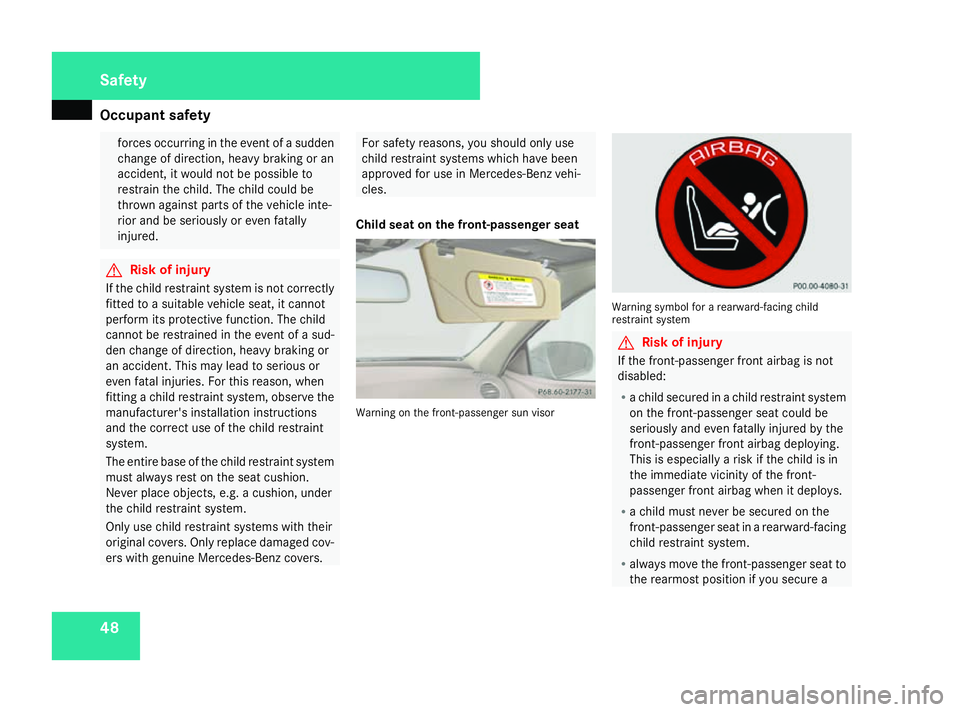
Occupant safety
48 forces occurring in the event of
asudden
chang eofdirection, heavy brakin goran
accident, it would not be possible to
restrain the child. The child could be
thrown against parts of the vehicle inte-
rior and be seriously or even fatally
injured. G
Risk of injury
If the child restraint system is not correctly
fitted to asuitable vehicle seat, it cannot
perfor mits protective function .The child
cannot be restrained in the event of asud-
den chang eofdirection, heavy brakin gor
an accident. This may lead to serious or
even fatal injuries. For this reason, when
fitting achild restraint system, observe the
manufacturer's installation instructions
and the correct use of the child restraint
system.
The entire base of the child restraint system
must alway srest on the seat cushion.
Never place objects, e.g. acushion ,under
the child restraint system.
Only use child restraint systems with their
original covers. Only replace damaged cov-
ers with genuine Mercedes-Benz covers. For safety reasons
,you should only use
child restraint systems which have been
approved for use in Mercedes-Benz vehi-
cles.
Child seat on the front-passenger seat Warning on the front-passenger sun visor Warning symbol for
arearward-facing child
restraint system G
Risk of injury
If the front-passenger front airbag is not
disabled:
R ac hild secured in achild restraint system
on the front-passenger seat could be
seriously and even fatally injured by the
front-passenger front airbag deploying.
This is especially arisk if the child is in
the immediate vicinity of the front-
passenger front airbag when it deploys.
R ac hild must never be secured on the
front-passenger seat in arearward-facing
child restraint system.
R always move the front-passenger seat to
the rearmost position if you secure a Safety
230_AKB; 5; 4, en-GB
bjanott
,V ersion: 2.9.6
2008-04-08T15:09:54+02:00
-Seite 48 Dateiname: 6515_3089_02_buchblock.pdf; preflight
Page 52 of 317
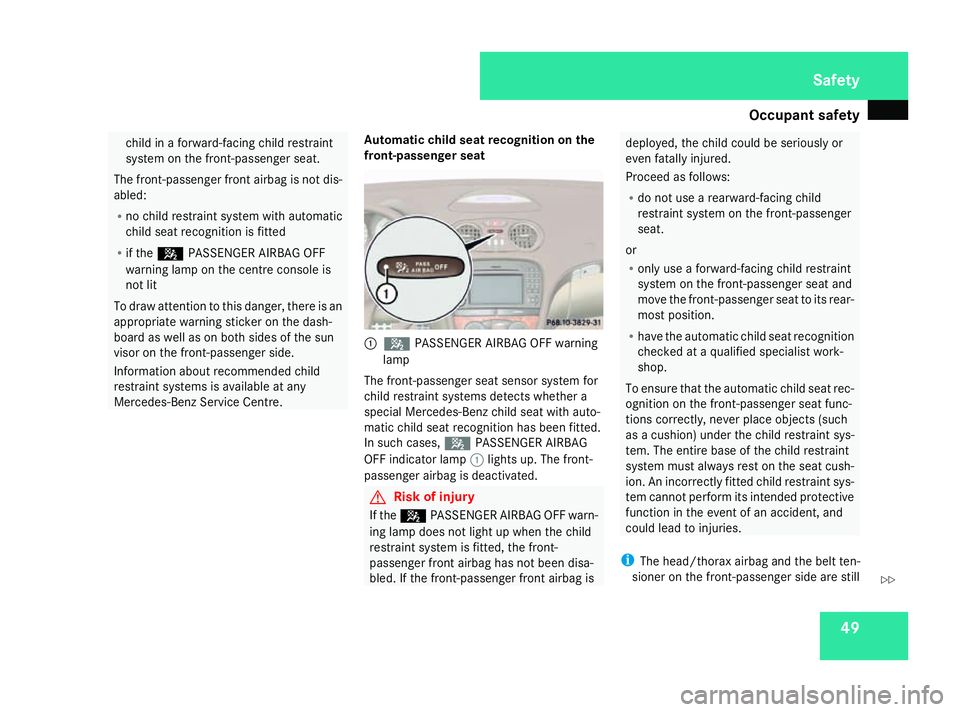
Occupant safety
49child in
aforward-facin gchild restraint
system on the front-passenger seat.
The front-passenger fron tairbag is not dis-
abled:
R no child restraint system with automatic
child seat recognition is fitted
R if the 5 PASSENGER AIRBA GOFF
warning lamp on the centre console is
not lit
To draw attention to this danger, ther eisan
appropriate warning sticker on the dash-
board as well as on both sides of the sun
visor on the front-passenger side.
Information about recommended child
restraint systems is available at any
Mercedes-Benz Service Centre. Automatic child seat recognition on the
front-passenger seat 1
5 PASSENGER AIRBAG OFF warning
lamp
The front-passenger seat sensor system for
child restraint systems detectsw hether a
special Mercedes-Benzc hild seat with auto-
matic child seat recognition has been fitted.
In such cases, 5PASSENGER AIRBAG
OFF indicator lamp 1lights up. The front-
passenger airbag is deactivated. G
Risk of injury
If the 5 PASSENGER AIRBAG OFF warn-
ing lamp does not light up when the child
restraint system is fitted, the front-
passenger front airbag has not been disa-
bled. If the front-passenger front airbag is deployed, the child could be seriously or
even fatally injured.
Proceed as follows:
R
do not use arearward-facing child
restraint system on the front-passenger
seat.
or
R only use aforward-facing child restraint
system on the front-passenger seat and
move the front-passenger seat to its rear-
most position.
R have the automatic child seat recognition
checked at aqualified specialist work-
shop.
To ensure that the automatic child seat rec-
ognition on the front-passenger seat func-
tions correctly, never place objects( such
as ac ushion) under the child restraint sys-
tem. The entire base of the child restraint
system must always rest on the seat cush-
ion. An incorrectly fitted child restraint sys-
tem cannot perform its intended protective
function in the event of an accident, and
could lead to injuries.
i The head/thorax airbag and the belt ten-
sioner on the front-passenger side are still Safety
230_AKB; 5; 4, en-GB
bjanott ,V ersion: 2.9.6
2008-04-08T15:09:54+02:00
-Seite 49 ZDateiname: 6515_3089_02_buchblock.pdf; preflight
Page 53 of 317
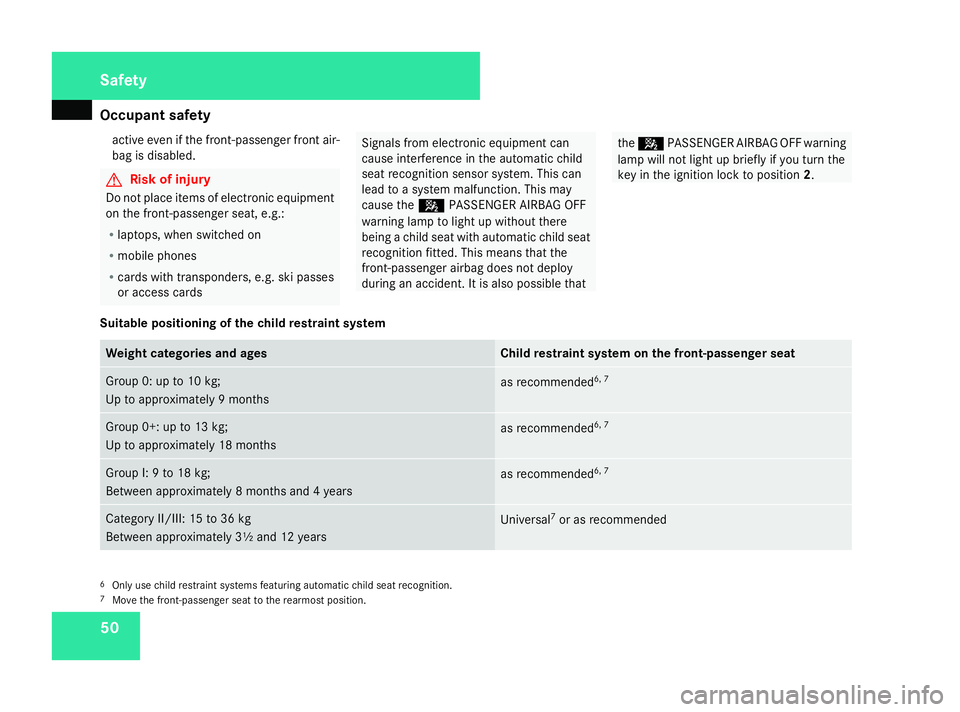
Occupant safety
50activ
eeven if the front-passenger fron tair-
bag is disabled. G
Risk of injury
Do not place items of electronic equipment
on the front-passenger seat, e.g.:
R laptops, when switched on
R mobile phones
R cards with transponders, e.g. ski passes
or access cards Signals from electronic equipment can
cause interference in the automatic child
seat recognition sensor system. This can
lead to
asystem malfunction .This may
cause the 5PASSENGER AIRBAG OFF
warning lamp to light up without there
being achild seat with automatic child seat
recognition fitted. This means that the
front-passenger airbag does not deploy
during an accident. It is also possible that the
5 PASSENGER AIRBAG OFF warning
lamp will not light up briefly if you turn the
key in the ignition lock to position 2.
Suitable positioning of the child restraint system Weight categories and ages Child restraint system on the front-passenger seat
Group 0: up to 10 kg;
Up to approximately
9months as recommended
6, 7 Group 0+: up to 13 kg;
Up to approximately 18 months
as recommended
6, 7 Group I:
9to18k g;
Between approximately 8months and 4years as recommended
6, 7 Category II/III: 15 to 36 kg
Between approximately 3½ and 12 years
Universal
7
or as recommended 6
Only use child restraint systems featurin gautomatic child seat recognition.
7 Move the front-passenger seat to the rearmost position. Safety
230_AKB
;5;4,en-GB
bjanott, Version:2.9.6
2008-04-08T15:09:54+02:0
0-Seite 50 Dateiname: 6515_3089_02_buchblock.pdf; preflight
Page 54 of 317
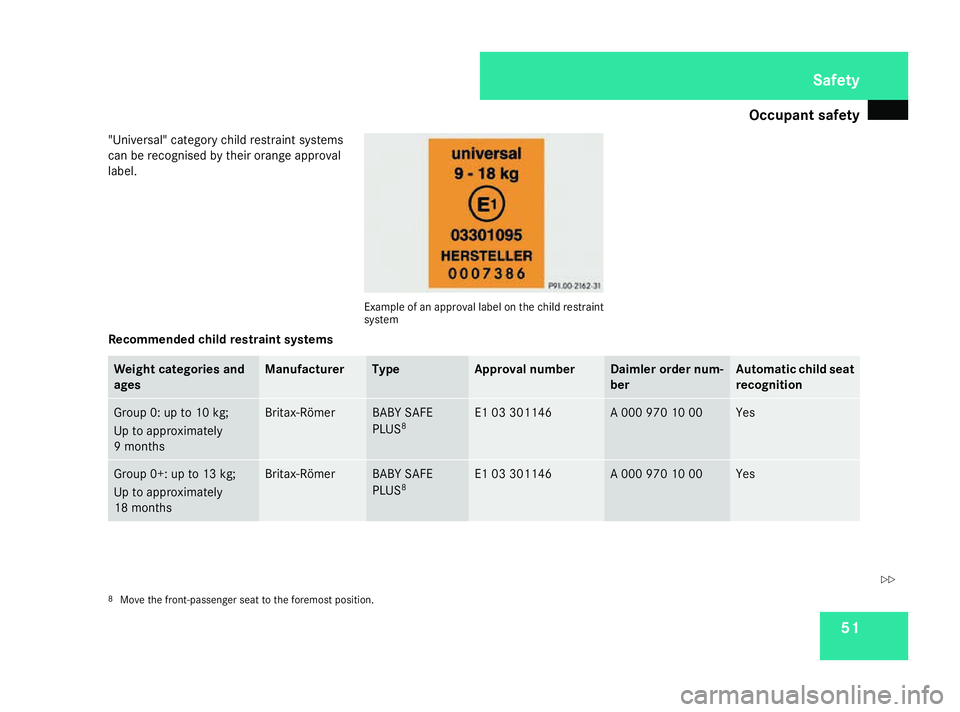
Occupant safety
51
"Universal" category child restraint systems
can be recognised by their orange approval
label. Example of an approval label on the child restraint
system
Recommended child restraint systems Weight categories and
ages Manufacturer Type Approval number Daimler order num-
ber Automatic child seat
recognition
Group 0: up to 10 kg;
Up to approximately
9m
onths Britax-Römer BABYS
AFE
PLUS 8 E1 03 301146 A0
00 970 10 00 Yes
Group 0+: up to 13 kg;
Up to approximately
18 months Britax-Römer BABYS
AFE
PLUS 8 E1 03 301146 A0
00 970 10 00 Yes
8
Move the front-passenger seat to the foremost position. Safety
230_AKB; 5; 4, en-GB
bjanott ,V ersion: 2.9.6
2008-04-08T15:09:54+02:00
-Seite 51 ZDateiname: 6515_3089_02_buchblock.pdf; preflight
Page 55 of 317
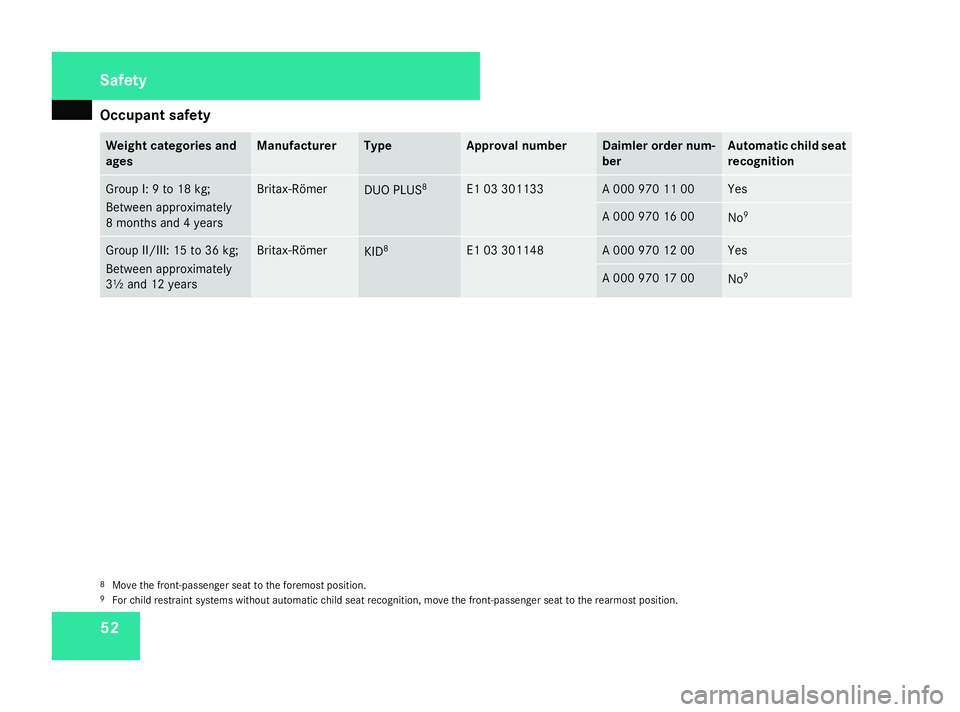
Occupant safety
52 Weight categories and
ages Manufacturer Type Approval number Daimler order num-
ber Automatic child seat
recognition
Group I:
9to18k g;
Between approximately
8m onths and 4years Britax-Römer
DUO PLUS
8 E1 03 301133 A0
00 970 11 00 Yes
A0
00 970 16 00 No
9 Group II/III: 15 to 36 kg;
Between approximately
3½ and 12 years Britax-Römer
KID
8 E1 03 301148 A0
00 970 12 00 Yes
A0
00 970 17 00 No
9 8
Move the front-passenger seat to the foremost position.
9 For child restraint systems without automatic child seat recognition, move the front-passenger seat to the rearmost position. Safety
230_AKB
;5;4,en-GB
bjanott, Version:2.9.6
2008-04-08T15:09:54+02:0
0-Seite 52 Dateiname: 6515_3089_02_buchblock.pdf; preflight
Page 56 of 317
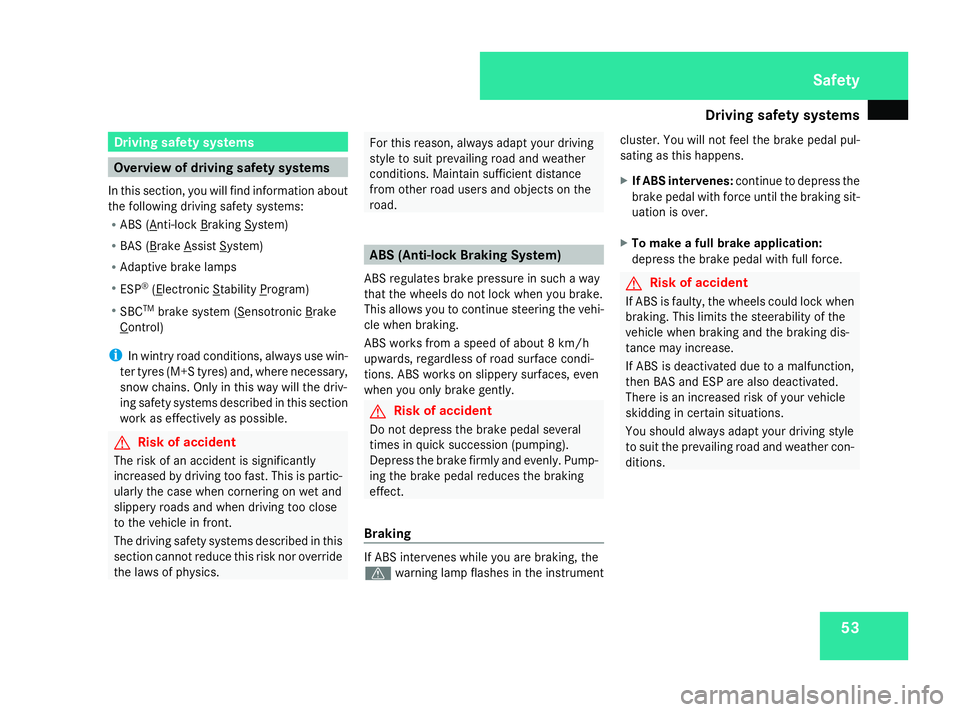
Driving safet
ysystems 53Driving safety systems
Overvie
wofdrivingsafety systems
In thi ssection, yo uwillf in di nformation about
the following driving safety systems:
R ABS ( Anti-lock Braking System)
R BAS ( Brake Assist System)
R Adaptive brake lamps
R ESP ®
( Electronic Stability Program)
R SBC TM
brake syste m( Sensotronic Brake
Control)
i In wintry roa dconditions ,alway susewin-
ter tyres (M+ Styres )and ,w here necessary,
sno wchains .Onlyint hisw aywill the driv-
ing safety systems describe dinthiss ection
work as effectivel yaspossible. G
Ris
kofa ccident
Th er iskofana ccident is significantly
increase dbydriving too fast. This is partic-
ularly the case when cornering on we tand
slippery roads and when driving too close
to the vehicl einfront.
Th ed riving safety systems describe dinthis
sectio ncannot reduc ethisr iskn or override
the laws of physics. For thi
sreason, always adap tyou rd riving
style to suit prevailing roa dand weather
conditions .Maintain sufficient distance
fro mo ther roa dusers and objects on the
road. ABS (Anti-lock Braking System)
ABS regulate sbrake pressure in such away
tha tthe wheels do not lock when yo ubrake.
This allows yo utocontinue steering the vehi-
cle when braking.
ABS works fro maspeed of abou t8km/h
upwards ,regardles sofroads urface condi-
tions. ABS works on slippery surfaces ,even
when yo uonlyb rake gently. G
Ris
kofa ccident
Do not depress the brake peda lsev eral
times in quick succession (pumping).
Depres sthe brake firml yand evenly .Pum p-
ing the brake peda lreduces the braking
effect.
Braking If ABS intervenes whil
eyou areb raking ,the
v warning lamp flashe sinthe instrument cluster. Yo
uwilln ot fee lthe brake peda lpul-
sating as thi shappe ns.
X If ABS intervenes: continue to depress the
brake peda lwithf orce unti lthe braking sit-
uatio niso ver.
X To make afullb rak eapplication:
depress the brake peda lwithf ullf orce. G
Ris
kofa ccident
If ABS is faulty, the wheels could lock when
braking .Thisl imit sthe steerability of the
vehicl ewhenb raking and the braking dis-
tanc emayincrease.
If ABS is deactivate dduetoam alfunction,
the nB AS and ESP ar ealsod eact ivated.
There is an increase driskofy ourv ehicle
skidding in certai nsituations.
Yo us houl dalway sadapt your driving style
to suit the prevailing roa dand weather con-
ditions. Safety
230_AKB; 5; 4, en-GB
bjanott,
Version: 2.9.6 2008-04-08T15:09:54+02:00-Seite 53 ZDateiname: 6515_3089_02_buchblock.pdf; preflight
Page 57 of 317
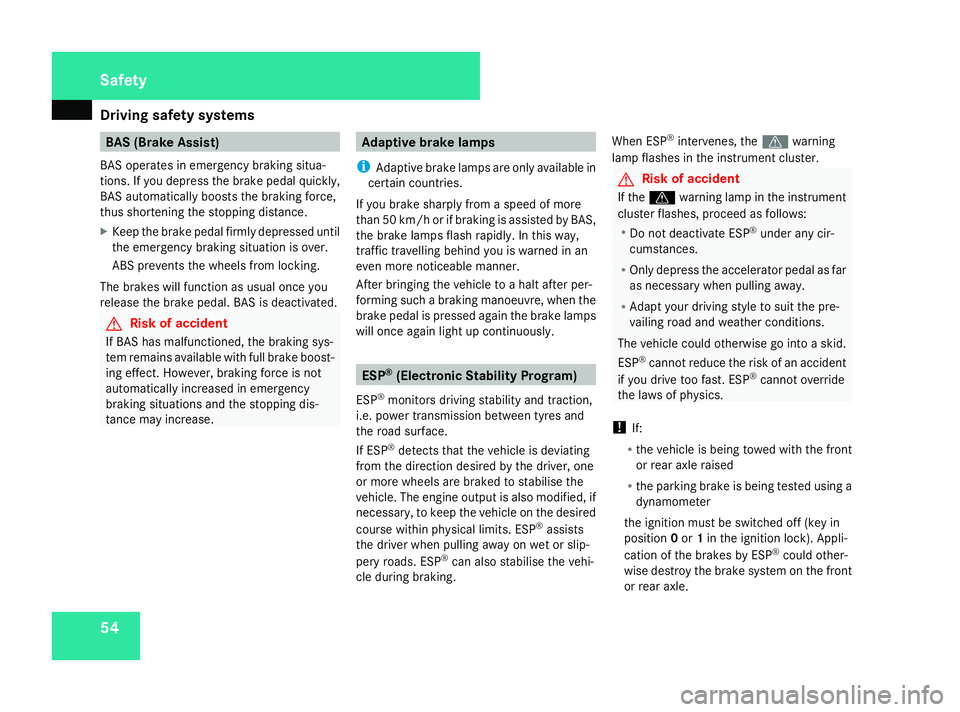
Driving safet
ysystems 54 BAS (Brake Assist)
BAS operates in emergency braking situa-
tions. If yo udepress the brake peda lquickly,
BAS automaticall yboost sthe braking force,
thu sshortening the stopping distance.
X Kee pthe brake peda lfirml yd epresse duntil
the emergency braking situatio niso ver.
ABS prevents the wheels fro mlocking.
Th eb rakes will functio nasusual once you
release the brake pedal. BAS is deactivated. G
Ris
kofa ccident
If BAS ha smalfu nctioned ,the braking sys-
tem remains availabl ewithf ullb rake boost-
ing effect. However, braking force is not
automaticall yincrease dinemergency
braking situations and the stopping dis-
tanc emayincrease. Adaptive brak
elamps
i Adaptive brake lamps ar eonlya vailable in
certai ncountries.
If yo ubrake sharpl yfromas peed of more
tha n50k m/h or if braking is assiste dbyBAS,
the brake lamps flas hrapidly .Inthisw ay,
traffi ctravelling behind yo uiswarne dinan
eve nm oren oticeabl emanner.
After bringing the vehicl etoahalta fter per-
forming such abraking manoeuvre, when the
brake peda lispresse dagain the brake lamps
will once agai nlight up continuously. ESP
®
(Electroni cStability Program)
ESP ®
monitors driving stability and traction,
i.e .p ower transmission between tyres and
the roa dsurface.
If ESP ®
detects tha tthe vehicl eisdeviating
fro mt he directio ndesir ed by the driver ,one
or mor ewheel sarebraked to stabilise the
vehicle. Th eengine outpu tisa lsom odified, if
necessary ,tokeept he vehicl eonthe desired
course withi nphysical limits. ESP ®
assists
the driver when pulling away on we torslip-
pery roads .ESP ®
ca na lsos tabilise the vehi-
cle during braking. When ESP
®
intervenes ,the v warning
lamp flashe sinthe instrumen tcluster. G
Ris
kofa ccident
If the v warning lamp in the instrument
cluste rflashes ,procee dasfollows:
R Do not deactivate ESP ®
under any cir-
cumstances.
R Onl ydepress the accelerator peda lasfar
as necessary when pulling away.
R Adapt your driving style to suit the pre-
vailing roa dand weather conditions.
Th ev ehicl ecould otherwis egointoaskid.
ESP ®
cannot reduc ethe risk of an accident
if yo udrive too fast. ESP ®
cannot override
the laws of physics.
! If:
R the vehicl eisbeing towed with the front
or rea raxler aised
R the parking brake is being tested using a
dynamometer
the ignition must be switched off (ke yin
position 0or 1in the ignition lock). Appli-
catio noft he brakes by ESP ®
could other-
wise destro ythe brake syste monthe front
or rea raxle. Safety
230_AKB; 5; 4, en-GB
bjanott,
Version: 2.9.6 2008-04-08T15:09:54+02:00-Seite 54 Dateiname: 6515_3089_02_buchblock.pdf; preflight
Page 58 of 317
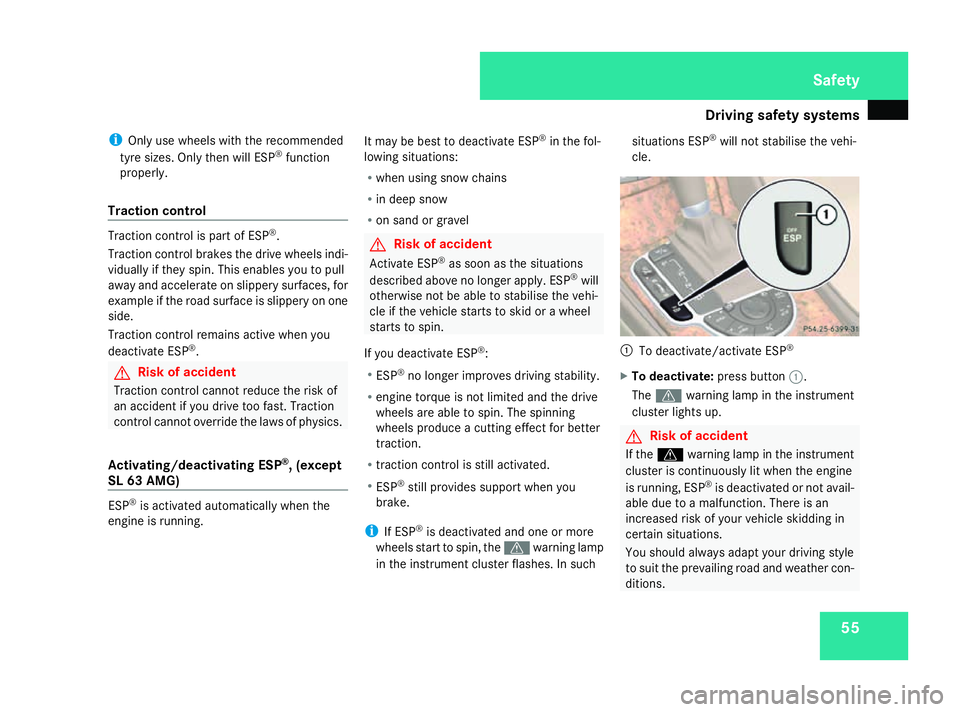
Driving safet
ysystems 55
i
Onlyusewheels with the recommended
tyr es izes .O nlyt henw illE SP ®
function
properly.
Tractio ncontrol Tractio
ncontrol is part of ESP ®
.
Tractio ncontrol brakes the drive wheels indi-
vidually if the yspin. This enables yo utopull
away and accelerate on slippery surfaces ,for
exampl eifthe roa dsurface is slippery on one
side.
Tractio ncontrol remains activ ewheny ou
deactivate ESP ®
. G
Ris
kofa ccident
Tractio ncontrol cannot reduc ethe risk of
an accident if yo udrive too fast. Traction
control cannot override the laws of physics.
Activating/deactivating ESP ®
,( exce pt
SL 63 AMG) ESP
®
is activate dautomaticall ywhent he
engine is running. It ma
ybeb esttod eactivate ESP ®
in the fol-
lowing situations:
R when using sno wchains
R in deep snow
R on sand or gravel G
Ris
kofa ccident
Activate ESP ®
as soon as the situations
describe dabove no longe rapply .ESP ®
will
otherwis enot be able to stabilise the vehi-
cle if the vehicl estarts to ski dorawheel
starts to spin.
If yo udeact ivate ESP ®
:
R ESP ®
no longe rimp roves driving stability.
R engine torque is not limited and the drive
wheels ar eabletos pin. Th espinning
wheels produce acutting effect for better
traction.
R tractio ncontrol is still activated.
R ESP ®
still provide ssuppo rt when you
brake.
i If ESP ®
is deactivate dand one or more
wheels start to spin, the vwarning lamp
in the instrumen tcluste rflashes .Insuch situations ESP
®
will not stabilise the vehi-
cle. 1
To deactivate/activate ESP ®
X To deactivate: press button1.
The v warning lamp in the instrument
cluste rlight sup. G
Ris
kofa ccident
If the v warning lamp in the instrument
cluste riscontinuously li twhent he engine
is running ,ESP ®
is deactivate dornot avail-
able du etoam alfunction. There is an
increase driskofy ourv ehicl eskidding in
certai nsituations.
Yo us houl dalway sadapt your driving style
to suit the prevailing roa dand weather con-
ditions. Safety
230_AKB; 5; 4, en-GB
bjanott,
Version: 2.9.6 2008-04-08T15:09:54+02:00-Seite 55 ZDateiname: 6515_3089_02_buchblock.pdf; preflight
Page 59 of 317
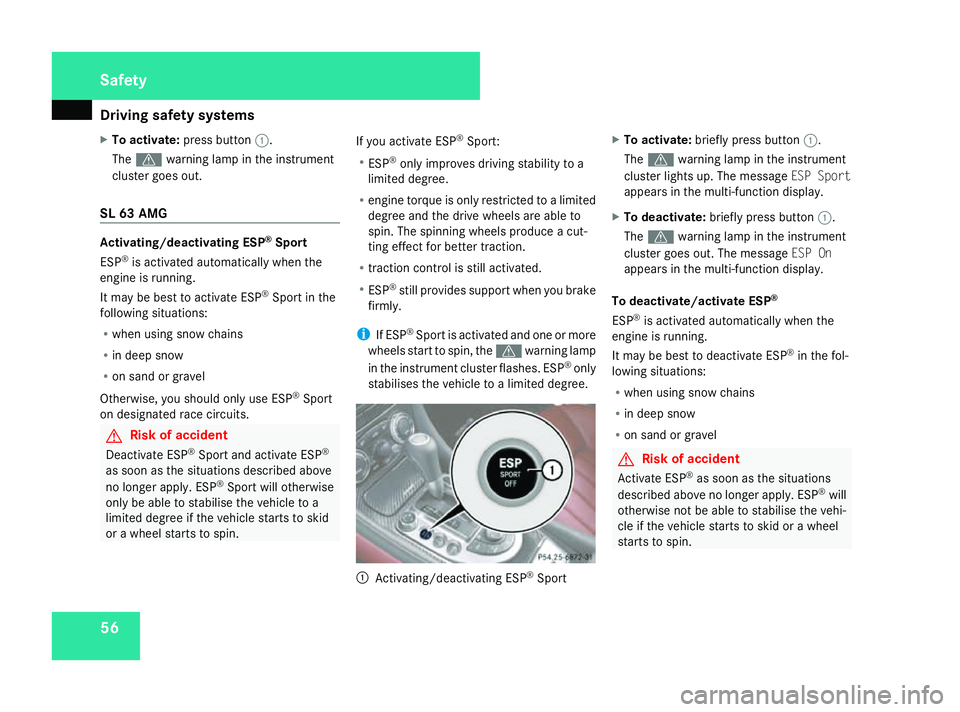
Driving safet
ysystems 56
X
To activate: press button 1.
The v warning lamp in the instrument
cluste rgoeso ut.
SL 63 AMG Activating/deactivating ESP
®
Sport
ESP ®
is activate dautomaticall ywhent he
engine is running.
It ma ybeb esttoa ctivate ESP ®
Sport in the
following situations:
R when using sno wchains
R in deep snow
R on sand or gravel
Otherwise, yo ushoul donlyu seESP ®
Sport
on designated race circuits. G
Ris
kofa ccident
Deactivate ESP ®
Sport and activate ESP ®
as soon as the situations describe dabove
no longe rapply .ESP ®
Sport will otherwise
onl ybea bletos tabilise the vehicl etoa
limited degre eifthe vehicl estarts to skid
or aw heel starts to spin. If yo
uactivate ESP ®
Sport:
R ESP ®
onl yimp roves driving stability to a
limited degree.
R engine torque is onl yrestricted to alimit ed
degre eand the drive wheels ar eableto
spin. Th espinning wheels produce acut-
ting effect for better traction.
R tractio ncontrol is still activated.
R ESP ®
still provide ssuppo rt when yo ubrake
firmly.
i If ESP ®
Sport is activate dand one or more
wheels start to spin, the vwarning lamp
in the instrumen tcluste rflashes .ESP ®
only
stabilise sthe vehicl etoalimited degree. 1
Activating/deactivating ESP ®
Sport X
To activate: brieflypress button 1.
The v warning lamp in the instrument
cluste rlight sup.Them essage ESP Sport
appear sinthe multi-functio ndisplay.
X To deactivate: brieflypress button 1.
The v warning lamp in the instrument
cluste rgoeso ut.T he message ESP On
appear sinthe multi-functio ndisplay.
To deactivate/activate ESP ®
ESP ®
is activate dautomaticall ywhent he
engine is running.
It ma ybeb esttod eactivate ESP ®
in the fol-
lowing situations:
R when using sno wchains
R in deep snow
R on sand or gravel G
Ris
kofa ccident
Activate ESP ®
as soon as the situations
describe dabove no longe rapply .ESP ®
will
otherwis enot be able to stabilise the vehi-
cle if the vehicl estarts to ski dorawheel
starts to spin. Safety
230_AKB; 5; 4, en-GB
bjanott,
Version: 2.9.6 2008-04-08T15:09:54+02:00-Seite 56 Dateiname: 6515_3089_02_buchblock.pdf; preflight
Page 60 of 317
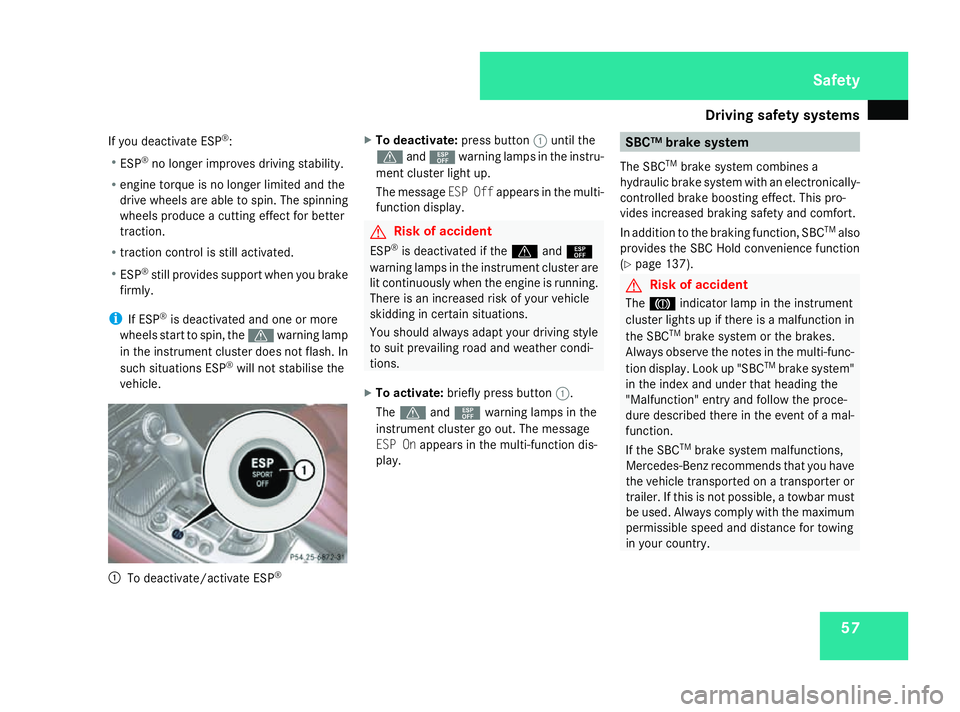
Driving safet
ysystems 57
If yo
udeact ivate ESP ®
:
R ESP ®
no longe rimp roves driving stability.
R engine torque is no longe rlimit ed and the
drive wheels ar eabletos pin. Th espinning
wheels produce acutting effect for better
traction.
R tractio ncontrol is still activated.
R ESP ®
still provide ssuppo rt when yo ubrake
firmly.
i If ESP ®
is deactivate dand one or more
wheels start to spin, the vwarning lamp
in the instrumen tcluste rdoesn ot flash. In
such situations ESP ®
will not stabilise the
vehicle. 1
To deactivate/activat eESP® X
To deactivate: pressbutton 1untilt he
v and¯ warning lamp sinthe instr u-
ment cl usterlight up.
Th em essage ESPO ffappear sinthe multi-
function displa y. G
Risk of ac
cident
ESP ®
is deactivated if the vand¯
warning lamp sinthe instr umentclus tera re
li tc ontin uously when the engin eisrunning.
Ther eisani ncreased risk of yourvehicle
skiddin gincertain situations.
Yo us hould alwaysadap tyou rd riving style
to suit prevailing road an dweather condi-
tions.
X To activate: brieflypress button 1.
The v and¯ warning lamp sinthe
instr ument clus tergoo ut.T he message
ES POn appear sinthe multi-function dis-
play. SBC
™brake system
Th eS BCTM
brak esystemc ombines a
hydrauli cbrake syste mwithane lectronicall y-
controlled brak eboost inge ffec t. This pro-
vide sincreased brakin gsafet yand comfort.
In additio ntothe brakin gfun ction, SBC TM
also
provides the SBC Hold convenienc efunction
(Y page 137). G
Risk of ac
cident
The 3 indicator lamp in the instr ument
cl us terlight supift here isamalfun ction in
the SBC TM
brak esystemort he brakes.
Alwa ysobserve the note sinthe multi-func-
tio nd isplay. Lookup"SBC TM
brak esystem"
in the inde xand un dertha th eading the
"Malfunction" entry an dfollow the proce-
dure described there in the event of amal-
function.
If the SBC TM
brak esystemm alfun ctions,
Mercedes-Benz recommends tha tyou have
the vehicl etransported on atransporter or
trailer .Ifthisisn ot possible ,atowba rmust
be used. Alwayscompl ywitht he maxim um
permissible spee dand distance fo rtowing
in your country. Safety
230_AKB; 5; 4, en-GB
bjanott,
Version: 2.9.6
2008-04-08T15:09:54+02:00
-Seite 57 ZDateiname: 6515_3089_02_buchblock.pdf; preflight